A mute swan pair bows in courtship.
(photo from Wikimedia Commons. Click on the image to see the original)
NOTE: Mute swans were imported to North America. Though beautiful they are very aggressive and pose a threat to our native waterfowl.
A mute swan pair bows in courtship.
(photo from Wikimedia Commons. Click on the image to see the original)
NOTE: Mute swans were imported to North America. Though beautiful they are very aggressive and pose a threat to our native waterfowl.
Who can see in the dark, fly silently, and hear their prey beneath deep snow? Owls!
Owls live on every continent except Antarctica, some in extreme heat, others in extreme cold. How do they thrive in the nighttime world? PBS NATURE explores their special talents on Owl Power, premiering next Wednesday, February 18.
The show explains some amazing facts about owls. Did you know that … Their eyes take up 70% of their skull. Their ear tufts aren’t for hearing, they’re for expressing moods(!). Owls can hear the sound-frequency of a mouse 10 times better than we can. And, to an owl the night is 2.5 times brighter than it is for us.
And there are cool video segments including…
Click on the screenshot above for a preview, then watch Owl Power on PBS next Wednesday February 18, 8pm EST/7pm CST. In Pittsburgh it’s on WQED.
(screenshot from PBS NATURE’s Owl Power)
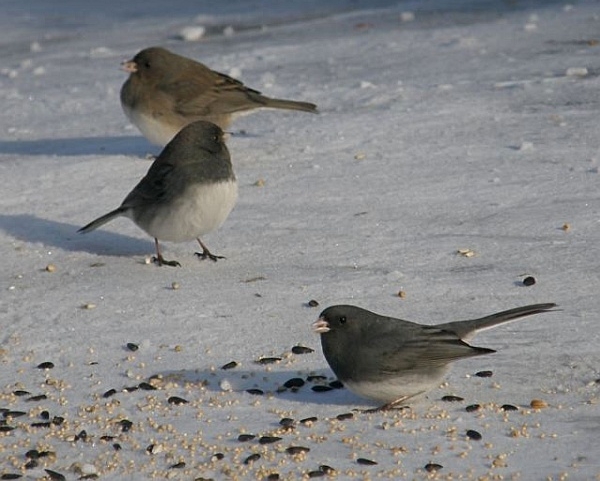
One week from today — February 13-16 — the Great Backyard Bird Count will take a real-time snapshot of the birds in North America and beyond.
Since 1998 the Great Backyard Bird Count has enlisted volunteers like us to count the birds we see for four days in mid-February. We count them in our backyards or anywhere we choose. Last year more than 142,000 volunteers tallied birds in 135 countries. Most of us count in North America so the northern cardinal and dark-eyed junco were the #1 and #2 birds. Click here to see which species was #3.
Counting is so easy you can participate from your kitchen window! Just fill your feeders, sit back with a cup of your favorite beverage, and tally the highest count of each species for at least 15 minutes. Then submit your observations online. Don’t be daunted. It’s really easy. Click here for instructions from Cornell Lab.
There are also outdoor events across the U.S. and in Pittsburgh –> Emerald View Park with Venture Outdoors, Three Rivers Birding Club & Fern Hollow Nature Center at Sewickley Heights Park, and Pittsburgh Botanical Garden.
If you love to take photographs, submit your best shots to the GBBC photo contest. Click here for contest information.
It’s as easy as 1-2-3.
February 13-16, 2015.
(Marcy Cunkelman counted 3 dark-eyed juncoes in this photo from her backyard.)
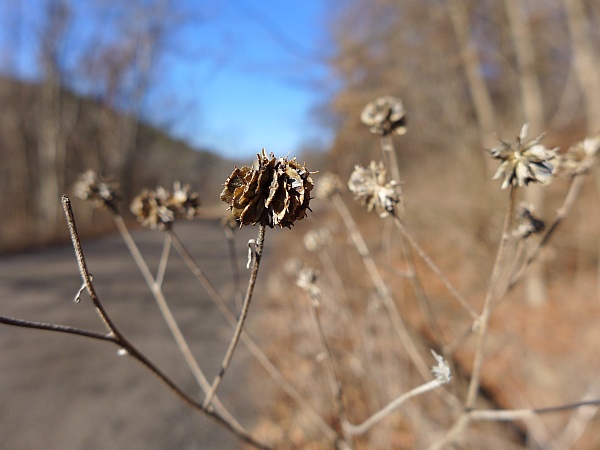
What can you find outdoors on January 1 in Pittsburgh? Nine intrepid naturalists from the Botanical Society of Western Pennsylvania and Wissahickon Nature Club hiked at North Park to find out.
Though yesterday was quite sunny the temperature hovered just below freezing and the wind was strong. We bundled up to look at seeds, trees, dry weeds, and birds.
Above, a wingstem seed pod looks just like a dried version of the flower’s central disk. Below, in the thicket we found juncoes, titmice and chickadees … and then changed our focus to identify the trees.
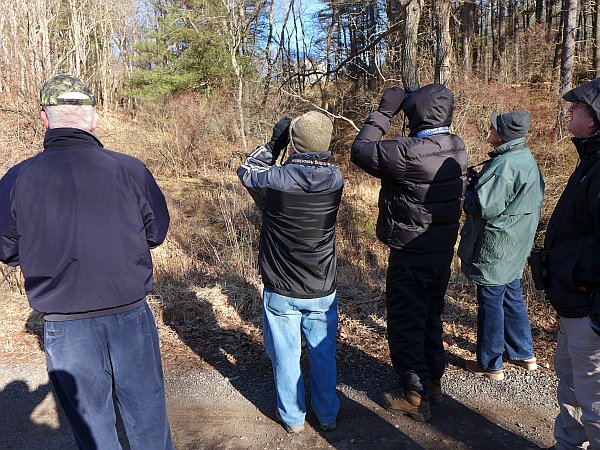
Dianne Machesney found this still-red scarlet oak leaf. I held it to take its picture.
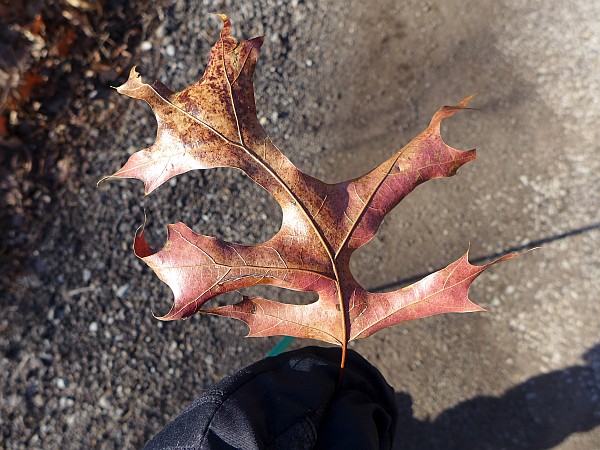
The ground wasn’t frozen but the creek had glimmering white ice.

After the hike, some of the party drove up Pearce Mill Road to check on the beaver dams on the North Fork of Pine Creek.
The beavers were snug in their beds while we braved the cold.

(photo credits: wingstem, hikers and oak leaf photos by Kate St. John.
Creek ice and beaver dam photos by Dianne Machesney)
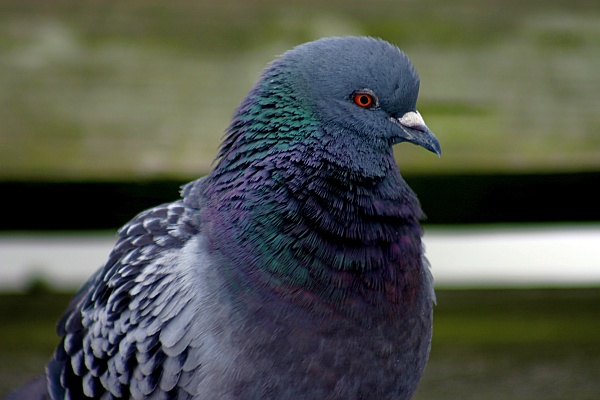
For those who list birds, January 1 starts a fresh new list for the new year. What bird will be the first of 2015?
If you live in the suburbs or countryside yours may be a songbird at the feeder — a cardinal, a chickadee, a dark-eyed junco — but where I live in the city the most likely first bird is a European import: a house sparrow, a starling, a pigeon.
Sometimes I make the list better by not looking outside until I think there’s a “good” bird outdoors. This usually requires a little cheating in which I ignore the hordes of foreigners to pick out the one native bird and call it my first.
Birding by ear is more successful at finding natives. Pigeons don’t coo on early January mornings, starlings are silent at dawn, and house sparrows are late risers. This method can give me a First Bird of song sparrow or Carolina wren but the most likely is American crow, cawing as they fly over my neighborhood on their way from the roost.
Today I shouldn’t cheat. I’ll just see what I come up with.
What’s your First Bird of 2015?
(photo by Chuck Tague)
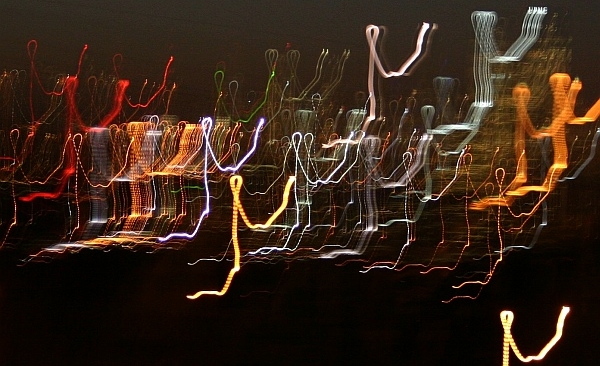
This flock isn’t found in nature. Are they angels? Ghosts? New Year’s Eve revelers?
No. I took this nighttime photo of the City of Pittsburgh from my attic window. I thought I was holding the camera steady but the light-tracks show I wasn’t.
Perhaps a tripod would have made it boring.
(photo by Kate St. John)

(Christmas decorations at Phipps Conservatory. Photo by Kate St. John)
p.s. Phipps is closed today but opens again tomorrow with more of the Winter Light Garden and Flower Show through January 11.
TBT: “Throw Back Thursday” (on Wednesday this week).
What species is the partridge in the pear tree?
Click here to find out in a blog article from Christmas Eve 2010.
(photo form Wikimedia Commons. Click on the image to see the original)
Today’s going to be a dark day in Pudasjärvi, Finland, where this photo was taken. Within the next 12 hours, the sun will reach its southern solstice(*).
Pudasjärvi is so far north (at 65.3619° N, 26.9859° E) that during the winter solstice the sun is up only 3 hours and 30 minutes, rising at 10:27am and setting at 1:58pm. At high noon it will be only 1.5 degrees above the horizon — barely risen — and to make matters worse the moon is New so it won’t provide any light at all.
The day will be brighter here in Pittsburgh with 9 hours and 17 minutes of sunlight — as soon as the heavy clouds open up and allow the sun to shine.
Starting tomorrow the days will get longer.
Things will get better. I promise!
(photo from Wikimedia Commons. Click on the image to see the original)
(*) The solstice is at 6:03pm Eastern Standard Time, 1:03am Eastern European Time.
This Friday November 21 visit Pitt’s Hillman Library for their Annual Audubon Day, 9:00am to 4:45pm.
This year the event commemorates the passenger pigeon and showcases Audubon’s 1824 passenger pigeon plate, believed to be the only bird he painted in Pittsburgh. Visit Room 363 to see this and more than 24 prints from John James Audubon’s Birds of America.
At 10:00am, in the Amy E. Knapp Room, don’t miss Chris Kubiak’s presentation on the the causes and consequences of the passenger pigeon’s extinction and the controversial effort to revive it through cloning.
Audubon Day is free and open to the public. Call 412–648-8199 or click on the image above for more information.
(photo of John James Audubon’s passenger pigeons, courtesy University of Pittsburgh. Click on the image to see the news release)